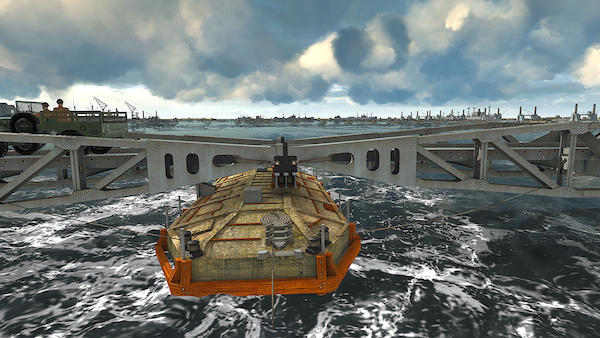Dassault Pays a 3D Modeling Tribute to D-Day
On the 75th anniversary of the World War II milestone, Dassault Systèmes employs the full complement of 3D modeling tools to memorialize past engineering innovations.

The Mulberry B artificial harbor was designed as a system of floating metal roadways mounted on pontoon units of concrete or steel. Image Courtesy of Dassault Systèmes.
Latest News
June 6, 2019
As the world commemorates the 75th anniversary of D-Day with tributes and presidential speeches, Dassault Systèmes has created an homage that calls out the engineering innovations of the past using its full complement of 3D modeling technologies.
As part of work conducted by the software giant’s Passion for Innovation Institute, teams have painstakingly recreated some of the core technologies used in the military operation that cinched the Allies' victory in World War II and changed the course of history. Specifically, designers and historians sought to safeguard the memory of the Waco gliders and Landing Craft Vehicle & Personnel (LCVP) that landed on the beaches of Normandy on June 6, 1944 with an interactive and immersive virtual reality experience created with Dassault Systèmes’ advanced 3D modeling and simulation platform.
Also recreated as a full 3D immersive experience was the artificial harbor assembled off the coast of Arromanches, France, which served as the first temporary deep water facility of its kind. Led by Major Allan Becket of the Royal Engineers, the artificial harbor, codenamed “Mulberry B,” was designed as a system of floating metal roadways mounted on pontoon units of concrete or steel, which connected the beaches to the floating pier heads and allowed large carriers like the LCVP to berth out at sea. Another first for the Mulberry B harbor design: The ability to float up and down with the tide, which allowed the operation to continue around the clock. The Mulberry B harbor, constructed in a mere three days, helped to land over 2.5 million men, 500,000 vehicles, 4 million tons of supplies.
“Virtually reconstructing the Arromanches artificial harbor, the LCVP landing craft, and the Waco glider is about bringing to life one of the most exciting episodes of 20th-century history for the broadest possible audience,” says Mehdi Tayoubi, vice president Global Digital & Experiential, Intrapreneurship & Innovation at Dassault Systèmes. “It’s about safeguarding this valuable part of our engineering heritage, which is gradually being lost as well as giving historians and engineers a set of powerful tools to support their research work.”
Engineering Innovation on Display
As part of the Institute’s “They Invented D-Day” simulation project, the LCVP and Waco CG-4A glider were also virtualized as 3D models to showcase their engineering innovations. The Waco CG-4A glider’s design put an emphasis on small, light, maneuverable and silent, while the LCVP had a flat-bottomed hull design that allowed it run right up to the shoreline.
Because few elements of the harbor remain, the team compiled what remained of the original plans to build the 3D simulation, including data from the Royal Engineers Museum in London, the construction and maintenance manuals, aerial photographs taken at the time, and additional information provided by Tim Beckett, the son of key Mulberry Harbor marine engineer. The data was brought together and scrutinized over a period of almost eight months by the lab teams.
“Using the 3DEXPERIENCE Platform, the teams were able to recreate the Mulberry Harbor and enable the son of its inventor to virtually stand on it in an immersive 3D experience,” Tayoubi says. “The 3D model is an accurate, scientific reconstruction of the harbor that will allow many to see and experience a site that was destroyed after WWII.”

The Dassault Systèmes teams also identified, located and gathered all available data in order to create detailed 3D models of both the Waco glider and LCVP landing craft, right down to the last nut and bolt, taking careful account of the specific materials used and how they would have behaved in actual conditions, he added.
In addition to the D-Day recreation, the Passion for Innovation Institute has also been at the center of a number of other projects to recreate or preserve history through simulation. For example, Dassault simulation technologies such as SIMULIA and DELMIA were used to bring the construction site of the Great Pyramid of Khufu to life to test the theory long championed by Jean-Pierre Houdin. Using a collection of photos, drawings, and documents from the Giza Archives at Boston’s Museum of Fine Arts, Giza 3D is an interactive 3D recreation of the Giza Necropolis, including the Khufu pyramid. The Dassault technology was also instrumental to the Paris 3D Saga project, which delivers an immersive journey of the history of Paris from -52 BC to 1889.
Watch this video to view the virtual 3D model of the Mulberry B artificial harbor.
And this video gives you a peak into the full “They Invented D Day” immersive experience.
More Dassault Systemes Coverage

Subscribe to our FREE magazine, FREE email newsletters or both!
Latest News
About the Author
Beth Stackpole is a contributing editor to Digital Engineering. Send e-mail about this article to [email protected].
Follow DE






